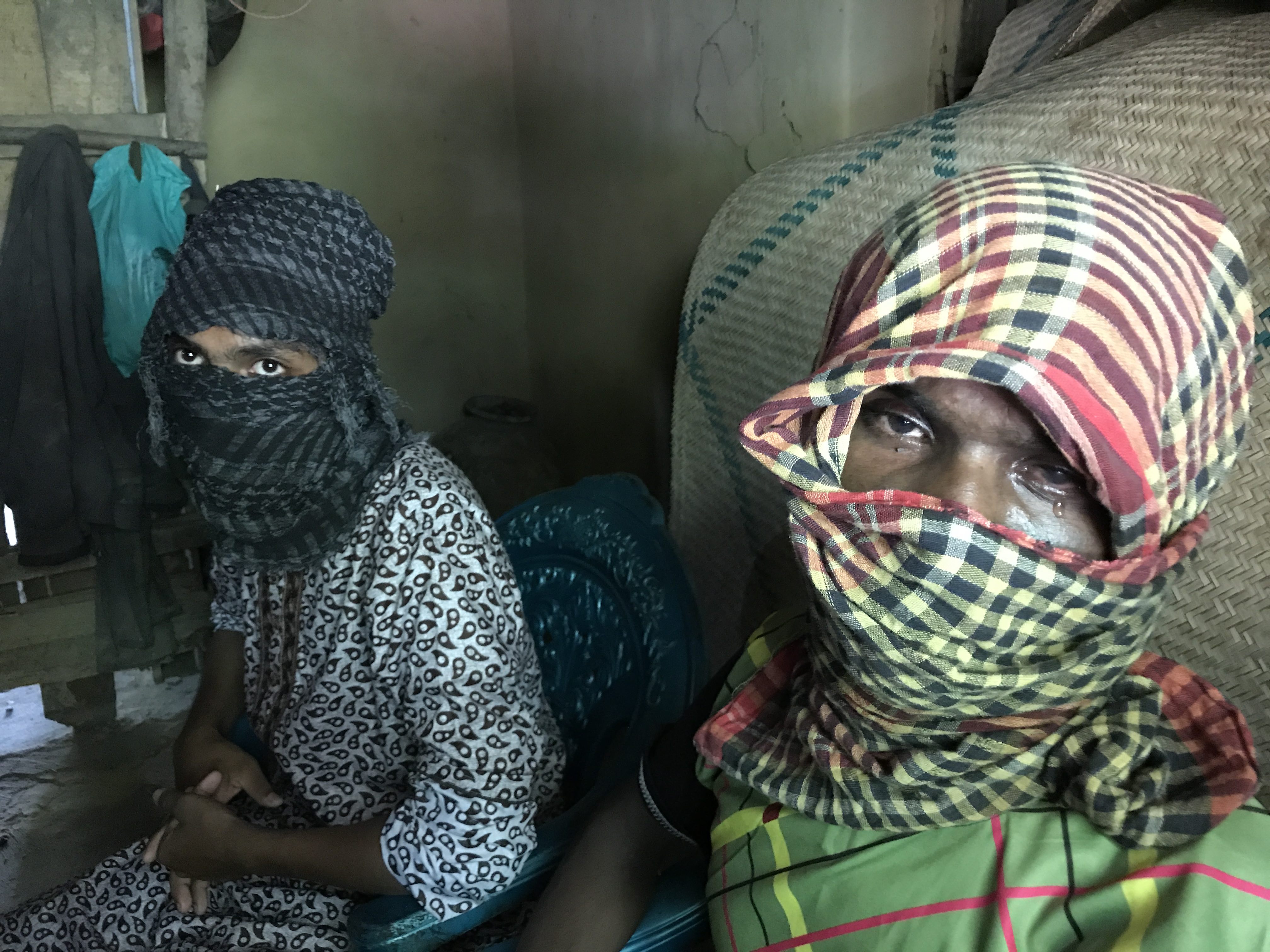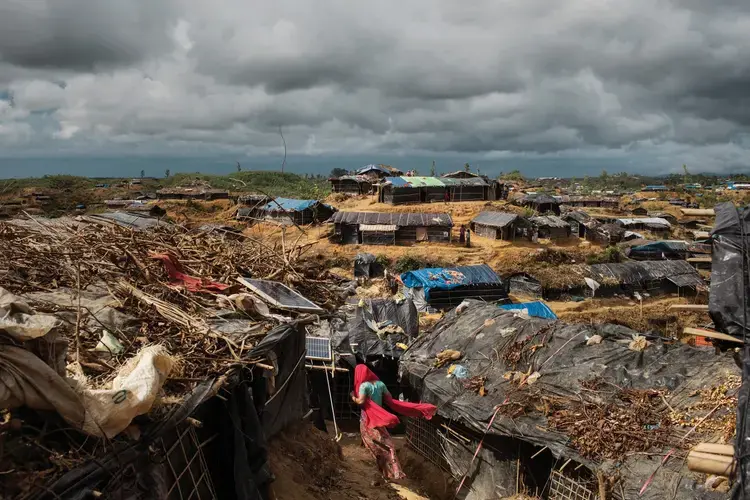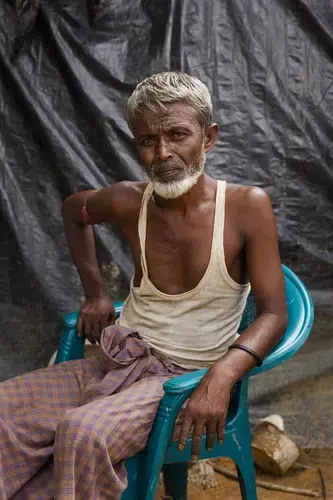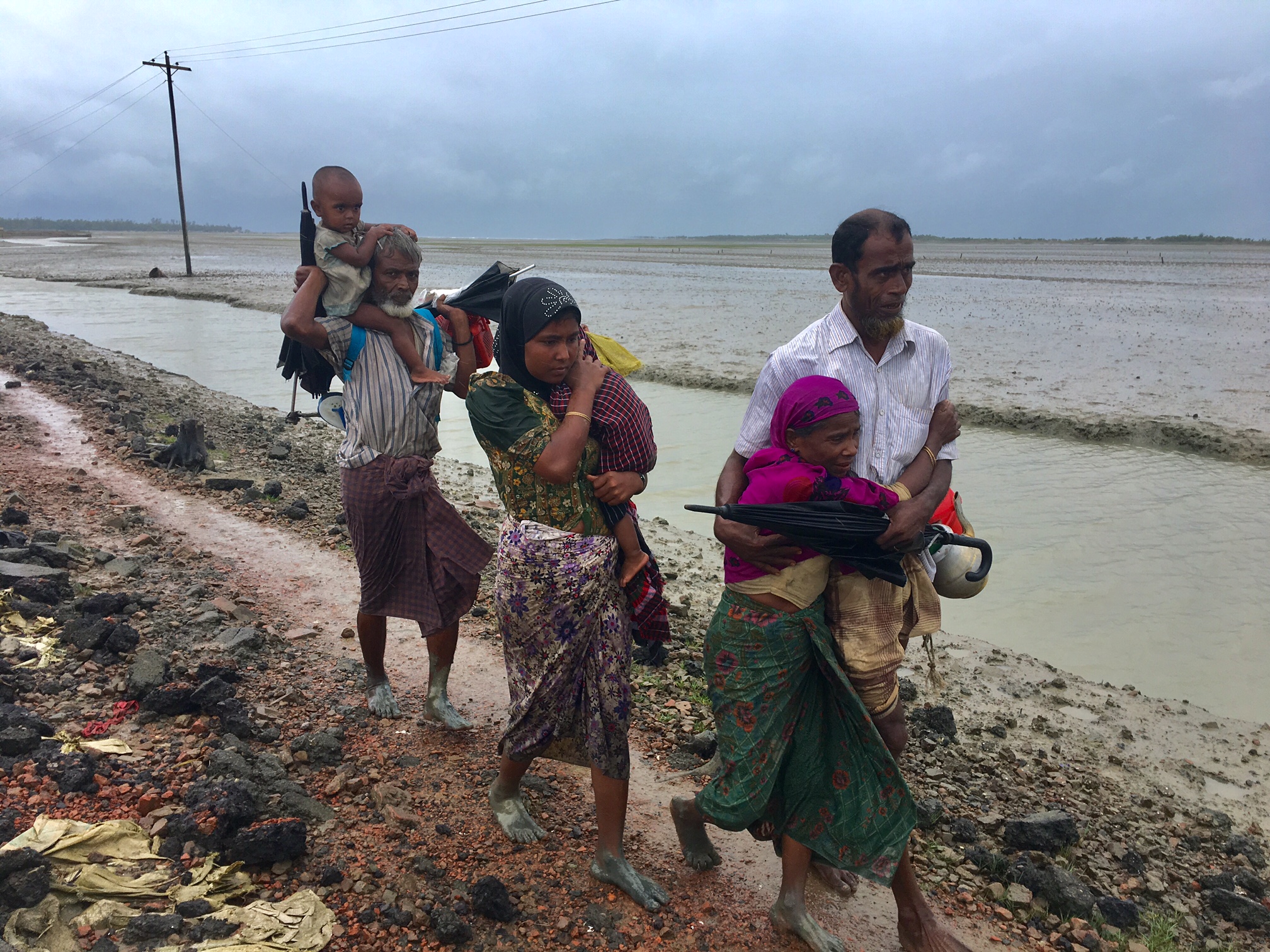
In the beam of a scanning flashlight, the family came into focus. A father, laboring under a sack filled with his belongings, used his free hand to pull a child no older than five, who hauled a bag of his own, as they struggled ashore from the Naf River. His wife lagged behind, clutching an infant with no pants. Once they made land, another man emerged from the dark water, his eyes downcast, carrying a young girl in his arms. They had reached Shah Porir Dwip, an island on the southeastern tip of Bangladesh, which meant they were safe from the government soldiers and Buddhist vigilantes from Myanmar who have hunted them for days and made life for their people, the Rohingya ethnic minority, unbearable for decades. They didn’t rejoice or cry—they were too exhausted, their murmurs drowned out by lapping waves and the motors of the boats readying to cross the river again for more people.
The second man, a 58-year-old farmer with silver hair that flowed into a brushy beard, was named Dudu Mia. The girl with him was his granddaughter, Dola Banu. She was two years old. Together, they waited for the rest of their relatives, ten in all. Once everyone safely reached land, they joined the other new arrivals in a procession to a makeshift rest area that had been set up in a village market. I spoke with Dudu Mia there, and he told me that about three weeks earlier, in late August, he began hearing rumors about Rohingya insurgents attacking Burmese security forces and provoking a brutal crackdown across the northern parts of Rakhine state. Every day, he climbed a large hill to monitor the smoke from burning hamlets nearby. He stopped sleeping, worried that his village would meet with the same fate. One morning, a Rakhine Buddhist leader—Rakhine Buddhists are the largest ethnic group in this part of Myanmar—arrived to issue an ultimatum: Leave by nightfall or they would be slaughtered. Even then, Dudu Mia and his family refused to go, until gunshots sent them running into the forest with whatever they could carry.
For four days, they pushed on through mud-slick hills and mountains, pounded every few hours by monsoon rains, always on the lookout for border guard patrols. They stopped next to a lake for water, and found the hacked bodies of other Rohingya people rotting in the 100-degree heat. They pressed on to the coast, where scores of people had gathered on the mudflats next to the Bay of Bengal. They paid a Bangladeshi boatman who agreed to take them across the Naf and into Bangladesh after nightfall. Waves crashed over the gunwales during the four-hour journey, but everyone held on in the pitch black.
In the market, as Dudu Mia recounted his story, Dola Banu, stunned and wide-eyed, nestled silently in his arms. He fed her some sugar biscuits that had been handed out by clerics from a local mosque, and then they lay down together on the ground to sleep. At dawn, they would continue on to Kutupalong, a vast and squalid network of refugee camps, home to several hundred thousand Rohingya displaced by previous waves of unrest, to look for relatives. In the stall next to them, a young mother cradled her baby son. He’d been born three days before the military attacked her village, she said. A scab festered on the back of the child’s head. While they fled into the bush a bullet had grazed him. I asked the boy’s name and she shook her head. “We haven’t named him. We were running for our lives.”

The crisis that upended their lives began on August 25, when militants from a small and disorganized insurgent group known as the Arakan Rohingya Salvation Army (ARSA) launched a series of nighttime attacks on Myanmar police outposts throughout northern Rakhine state and killed 12 officers. Armed with rifles, sticks, machetes, and homemade bombs, the assault backfired catastrophically. Under the pretext of militant “clearance operations,” Myanmar’s military and Rakhine Buddhist vigilantes burned some 300 villages in a months-long, and ongoing, pogrom of indiscriminate killing, mass rape, and arson. By November, more than 600,000 Rohingya—over half their 1.1 million population—fled Myanmar, the world’s fastest mass exodus since the Rwandan genocide.
“I’ve been doing this for 20 years, and some of the stories here have been the most shocking of my career,” said Peter Bouckaert, emergencies director for Human Rights Watch. Bouckaert, a Belgian-born lawyer and expert on humanitarian crises, had been interviewing Rohingya refugeesfor several weeks, and their stories were harrowing. Survivors from one massacre told him that the Myanmar Army had split up the Rohingya in one village by sex and executed the men. The women were then forced to watch as their infants were smashed to death on the ground. They were then beaten, raped, and burned alive. “There’s no end in sight,” Bouckaert said. “The Burmese army is not going to stop until the last Rohingya has been pushed out of Myanmar—that’s very clear.”
Myanmar’s generals have alleged that foreign-funded “extremist terrorists” fighting for an Islamic state in Rakhine are responsible for the atrocities.
Despite international condemnation and damning media coverage, the authorities in Myanmar have denied wrongdoing, alleging that foreign-funded “extremist terrorists” fighting for an Islamic state in Rakhine are responsible for the atrocities, a flimsy nod at global war on terror rhetoric used to justify acts of aggression around the world since 2001. Their stance was echoed by Aung San Suu Kyi, the Nobel Peace Prize laureate and, since 2015, four years after the inception of civilian rule, the country’s nominal leader. After a four-week-long silence, Suu Kyi issued a tepid statement about the slaughter, noting that the Myanmar government, and those abroad, needed to “decide how to differentiate terrorists from innocents.” A message on her Facebook page posted on September 6 blamed “terrorists” for “a huge iceberg of misinformation” about the violence. When she finally visited Rakhine in November, she said only, “We all have to try our best to live peacefully”—and made no mention of the crimes committed there.
Suu Kyi’s reputation took a battering in the West, and deservedly so. But the focus on her hypocrisy deflects responsibility from the country’s generals, who ran the country for 50 years, and who still hold enormous power. They are the engineers of the deep-seated xenophobia that fuels the ethnic cleansing campaign being waged against the Rohingya Muslims, and they are the ones using the cover of anti-terrorist Islamophobia to justify the violence. “The military wants the world to believe they’re fighting a Myanmar version of ISIS,” says Matthew Smith, CEO of Fortify Rights, a human rights organization that focuses on Myanmar. “It’s calculated, cultivated hysteria. And the ugly irony is that the military is claiming the Rohingya pose this threat while simultaneously destroying them.”
Myanmar’s anti-Rohingya policy dates to the colonial-era British government, which drew previously unimportant distinctions between the country’s more than 135 ethnic groups. Cultural differences hardened further after the 1947 assassination of Suu Kyi’s father, General Aung San, whose death ended hopes of a multi-ethnic federal system and paved the way for military dictatorship. To ensure stability among the country’s semi-autonomous states, the military manipulated ethnic and religious identities, pitting minority groups against one another, and emphasizing the superiority of the Buddhist Bamar “as true sons of the soil,” says Francis Wade, author of Myanmar’s Enemy Within: Buddhist Nationalism and Anti-Muslim Violence. “The military helped politicize ethnicity and gave rise to violent divides between groups that had previously known more fluid relations,” he added. The military leaders also advanced the idea that some groups were native and others were not, and that those “others,” according to Wade, comprised a hostile outside force, one which, in the case of the Rohingya, was dedicated to “overwhelming the land and resources in Rakhine state and furthering the Islamization of Myanmar.”
The generals have tried to leverage Islamophobia in the United States to their advantage as well. On October 10, 2002, with Myanmar under Western sanctions for human rights violations and isolated from the international community, the U.S. State Department received an unusual cable from its Yangon mission. Myanmar’s intelligence service claimed that two militant groups then based in Bangladesh, the Rohingya Solidarity Organization and the Arakan Rohingya National Organization, had spoken with the Taliban or received training from Al Qaeda operatives, and that five ARNO members actually met with Osama bin Laden. The U.S. Embassy interpreted the cable as an attempt by the generals “to bolster relations with the United States by getting credit for cooperation on the [counterterror] front.” No hard evidence was ever put forward to link Rohingya groups with foreign terrorists. The cable arrived the day before the U.S. Senate authorized the war in Iraq, which was itself based on false intelligence about links to Al Qaeda. Fifteen years later, the generals have used the same tactics to sell the Rohingya ethnic cleansing.
At first light, Dudu Mia’s family boarded a skiff that ferried them from Shah Porir Dwip island to the “broken road,” a cracked spine of mud and pavement that snakes toward the Bangladesh mainland. Leaden clouds warned of a coming storm as the family got off the boat and walked single-file in sucking mud toward a military-run relief depot that housed hundreds of exhausted, sick, and starved refugees. Bangladeshi soldiers guided everyone into a narrow fenced-off pen. The children were vaccinated against polio and measles and issued fresh clothing and snacks, and then everyone was loaded onto diesel flatbed trucks headed north to Kutupalong.
Dudu Mia was born in 1959 in Mrauk U, a region in Myanmar of rolling hillocks and pagodas, which was once the capital of the Arakanese kingdom that counted Rohingya as its subjects. Barred from attending school by the ruling junta, he worked as a sharecropper on a rice farm with his father. Though his family had lived in Rakhine for generations, a 1982 Myanmar nationality law enacted by the military effectively classified them as foreigners. Rohingya were not recognized as one of the country’s eight “national races,” and any future possibility of full citizenship was foreclosed. The government imposed restrictions on birth, marriage, and movement, and even refused to recognize the term Rohingya, opting for “Bengali,” which is considered a derogatory term. In 1991 and 1992, military repression drove some 250,000 Rohingya into Bangladesh, the first wave of refugees in what are now permanent camps. The government relocated Dudu Mia and his family to Maungdaw, one of three main townships in Rakhine where Rohingya were concentrated. He snuck back to his home a year later, only to be expelled again, this time to Buthidaung township in Rakhine, where he has lived ever since on a small plot with several cows and goats, riding out sporadic outbursts of communal violence and state-sanctioned attacks.
I first traveled to Rakhine in February 2013, after riots that had been sparked by the rape and murder of a young Buddhist woman. The Rohingya bore the brunt of the bloodshed, with at least 200 people killed. Another 140,000 were corralled into camps in eight townships in the state, on the pretext of protecting them from the mobs. The apartheid-like conditions proved to be a slow-motion death sentence. Hemmed in between barbed wire and the Bay of Bengal, children died of malnutrition and treatable illnesses like diarrhea, and adults were unable to find work, or even to fish. Government intimidation prevented many foreign aid groups from working to help the Rohingya. In 2014, Médecins Sans Frontières was kicked out of Rakhine, and U.N. representatives in Sittwe, the state capital, evacuated after attacks on their offices by Buddhist mobs.

As despair in the camps yielded to desperation, growing numbers of Rohingya began taking their chances at sea in rickety vessels bound for Muslim communities in Thailand, Malaysia, and Indonesia. Many of them died in boats that capsized or went adrift. Those who survived the journey often found themselves ensnared by human traffickers or held hostage in jungle camps where they were tortured and raped to extract ransoms. The boat exodus nonetheless continued and, for a brief period in early 2015, made global headlines due to the spectacle of Muslim authorities pushing boats packed with Rohingya asylum-seekers back out to sea. Under these conditions, violence from the Rohingya was perhaps inevitable.
On October 9, 2016, Rohingya militants struck three Burmese police posts, killing nine officers. In a video released afterward, the movement’s leader, a Rohingya man dressed in black and going by the name Atta Ullah, called on his people to rise up and to defend themselves. “We are not terrorists,” he said. “God willing, we will take back our rights from the brutal and unjust government.” Predictably, the Burmese government claimed that Atta Ullah had spent time in terrorist training camps with the Taliban in Pakistan, and that the militants hoped to establish an Islamic state within the country. Some Western analysts and media echoed these claims, with vague assertions about ARSA being well trained, armed, and financed, and having links to the Islamic State.
Little is known for certain about Atta Ullah, but he is believed to have been born in Pakistan to a Rohingya father who had fled violence in Myanmar. He grew up in Saudi Arabia and was educated in an Islamic religious school. He has likely received financial support for his insurgent campaign from businessmen in the Rohingya diaspora. Yet there exists no strong evidence—and little reason to believe—that ARSA has ties to transnational extremist organizations. YouTube videos of ARSA fighters on patrol reveal a poorly outfitted group carrying a smattering of old guns and farm tools; most young men are armed with nothing more than sticks. And there is no better illustration of the group’s inefficacy than the disastrous August 25 attack.
Shortly after arriving in Bangladesh in September, I met with an acquaintance of Atta Ullah’s in one of the refugee camps. A young, clean-shaven doctor from Buthidaung, he said Atta Ullah first approached him in early 2016 and asked him to join the movement. The doctor, who asked to remain anonymous for fear of reprisal from ARSA leaders, said no, but the two men grew friendly during Atta Ullah’s visits to the doctor’s clinic. (The doctor says Atta Ullah is diabetic and has high blood pressure and heart problems.) The doctor described Atta Ullah as charismatic and with some knowledge of the Koran, but as otherwise “barely literate,” traveling with a core group of deputies “easily influenced by him.” The doctor never saw a single foreigner among them. They carried basic rifles and a few machine guns, he said, some of them looted from the October 2016 attack. He had treated several ARSA fighters who had sustained gunshot wounds in skirmishes with the military, but when the armed forces and Buddhist vigilantes swept into his town during the crackdown, he fled with everyone else. The last time he saw Atta Ullah was September 7, on the outskirts of a Rohingya village. Atta Ullah pleaded with him not to leave the country. The doctor replied that he had no choice: His home and clinic had already been destroyed. “When we think of ARSA, it’s all negative,” he said. “They made hell worse for us.”
The doctor agreed to connect me with ARSA militants hiding in the camps. One of them, a 21-year-old man named Mohammad, told me he joined ARSA after the October 2016 violence, during which people from his village were beaten and raped. “We could not take the pain anymore,” he said. One day a local ARSA recruiter assembled him and 15 other men in a clearing and told them to “take back their rights” with whatever weapons they had when the time came. In July, several weeks before the fighting started, Mohammad said Burmese security forces showed up in his village and confiscated all household knives and tools, as if they were preparing for something. On August 25, he woke to the sound of gunshots; unarmed and unawares, he fled into the bush. An Army patrol spotted him and he was shot twice, in the groin and hip. His brother and a friend lashed him to a chair attached to bamboo poles and carried him for ten days to Bangladesh, where he recovered. “We are angry with our leaders,” he said. “They didn’t provide any proper training or weapons.”
Resentments were not limited to low-level members. An ARSA officer I will call Mansoor told me that he was a hafiz, a Koranic scholar who has memorized the Islamic holy book. Long frustrated by the stifling restrictions against the Rohingya, he joined after officers beat up his brother to extort money. He became responsible for recruitment in a dozen villages, reporting directly to one of Atta Ullah’s deputies. Even this did not grant him advance warning of the August 25 attacks, which he said shook him out of bed. “The military started using heavy weapons on us and we could not resist them,” he said.
Mansoor said that ARSA’s strategy was a “mistake,” and that he was done fighting. But he didn’t believe that the group should be blamed for the ethnic cleansing. “For the last 70 years, the military has had a plan to wipe the Rohingya out from Rakhine state,” he said. “They were looking for an excuse to do so.”
After stopping at a military checkpoint on the mainland, the diesel truck carrying Dudu Mia and 40-odd other refugees in its open flatbed lurched into gear. They huddled with their belongings and tried to rest, but lashing rains and the brutal condition of the road made that impossible. It wasn’t long before all the jouncing around had passengers vomiting over the side. When Dola Banu, Dudu Mia’s granddaughter, threw up in his hand, he cupped it for the duration of the ride to avoid standing up and getting her soaked.
Three hours later, the truck pulled onto the main road for Kutupalong and its satellite camps. Discarded clothing littered the ground on both sides. On a small plateau, the military was building barracks to establish a stronger presence in the area. Stick-wielding soldiers struggled to prevent a stampede as volunteers handed out sacks of food, and fluorescent relief agency posters designated fresh tracts of land that were being cleared to accommodate new arrivals. Bangladesh is one of the world’s poorest and most densely populated countries. It lacks the resources to contend with a humanitarian crisis on the scale of the Rohingya. While many refugees are formally registered and provided with housing, food, and medicine, the risk of a major public health disaster remains high. “As soon as a typhoon or an epidemic like cholera hits these camps, people are going to die in massive numbers,” said Human Rights Watch’s Bouckaert, who said he had witnessed something similar in Haiti. “This could be much worse because of the congested nature of these camps and the lack of sanitation. It’s just a disaster in the making.”
The truck pulled to a stop at a bend in the road, and bearded men in prayer caps and white shalwar kameez appeared to distribute boxes of chicken biryani. Everyone sat down to eat and the men shot selfies with the refugees in the background. Dudu Mia and his family ate and then set out to find a relative living in the camp. Eventually, they located the cousin’s home at the edge of an earthen bank surrounded by sewage. Inside, the women of the family tearfully embraced. Dudu Mia squatted on the porch and pulled out a half-smoked cheroot that he had saved since before he left Rakhine. He was far from his home and unlikely to see it again. Yet he knew that compared to many Rohingya he was lucky: His immediate family was intact. “Here at least we can sleep in peace,” he said. “There is no fear of being killed.”
That same evening, a smuggler’s boat carrying approximately 80 Rohingya refugees capsized in rough water off Inani beach, within view of a five-star hotel where families were on holiday. The boat was originally headed for Shah Porir Dwip, but late in the crossing the boatmen apparently decided to reroute further north to find a stretch of coast unmonitored by border guards. The boatmen kept the Rohingya at sea for almost a day in rough weather until a wave smashed the craft apart about 100 meters from shore and sent everyone screaming overboard. The boatmen had life vests; the Rohingya did not.
In the chaos, a refugee from Buthidaung named Jafar was separated from his wife, Tayyeba, and their two-month-old son, Nur Quryas. He was flailing to stay afloat and clutching his two older sons, Mohammad Zaber and Yasin, when another set of waves rolled over the boat and ripped the boys away. Jafar swam ashore as locals plunged in to help. By morning, 23 corpses washed up, Jafar’s wife and children among them. Villagers wrapped them in white cloth and they were buried side by side on the edge of a local cemetery.
I met Jafar the day after he lost his family, at a coastal village near the gravesite. “The Burmese government is responsible for all these deaths,” he said in a low, flat voice. “If they did not persecute us to such an extreme level, we would have never left our country.” When the afternoon downpour finally stopped, aid workers drove him and the other survivors to a shelter in Kutupalong.
Four days later, while driving along the coast south of the camps, I saw thick skeins of smoke surging into the sky across the river in Myanmar. It was more than a month into the ethnic cleansing and Rohingya villages were still being put to the torch. An Army helicopter appeared and circled above the smoke—contradicting Suu Kyi’s claim that “clearance operations” had ended three weeks earlier, and the generals’ obscene assertion that the Rohingya had set their own communities ablaze. Thousands of refugees continued to cross the river every day.
In the absence of a massive—and unlikely—international effort to protect the Rohingya, the false terrorism rationale used for the killing may become a reality. Al Qaeda has urged Muslims around the world to send aid and weapons to the Rohingya. Hard-line clerics from Bangladesh, Saudi Arabia, and Turkey were a visible presence in the camps during my visit, moving freely with megaphones and handing out money. Although ARSA seems to have been crushed as an active force, more radical groups among the vulnerable refugees could easily step into the void created by their suppression. “The only way to prevent people from being pushed into radicalism is by looking after their plight, defending their rights, and taking action to stop the massacres of their people,” said Bouckaert.
First-person accounts of massacres and satellite imagery of destroyed villages show that crimes against humanity, and perhaps even genocide, have occurred in Rakhine.
Myanmar continues to prevent journalists and investigators from independently verifying what is transpiring in northern Rakhine state, but first-person accounts of massacres, and satellite imagery of destroyed villages, show that ethnic cleansing, crimes against humanity, and perhaps even genocide have occurred. (There are also indications that ARSA has executed suspected spies and forcibly conscripted Rohingya teenagers.) Under international law, genocide requires proof of intent. In 2015, a team from Yale Law School had already found evidence of genocidal intent by the government against the Rohingya, and a new report by Fortify Rights and the U.S. Holocaust Memorial Museum concludes that the evidence of genocide is mounting. Regardless of the semantics, the atrocities in Rakhine are exactly what they look like. At the very least, there is sufficient evidence for the International Criminal Court to investigate General Min Aung Hlaing, the commander-in-chief of Myanmar’s armed forces, and other perpetrators for atrocity crimes.First-person accounts of massacres and satellite imagery of destroyed villages show that crimes against humanity, and perhaps even genocide, have occurred in Rakhine.
But who will make that happen? The U.N. Security Council cannot be counted on to refer Myanmar to the ICC. China, which sits on the council, remains Myanmar’s closest ally, and it is one of the only countries willing to lend credibility to the ARSA-terrorist narrative. China has made multibillon-dollar investments in Myanmar, including a new economic processing zone in Rakhine that features an industrial park, oil and gas terminal, and a deep-water port. It will likely block any harsh measures proposed for the country.
Accommodation by Western countries has eased the military’s path as well. Privately, diplomats express disgust over the military’s depredations against the Rohingya and other minorities, but publicly they refuse to confront them. In 2014, a Western ambassador told an acquaintance of mine that his government had allowed the generals to operate with such impunity elsewhere that “we haven’t pushed them on Rakhine.” Nearly every diplomatic mission, and the U.N. leadership in Myanmar, opposed the establishment of a U.N. fact-finding mission after the 2016 violence. If the generals are pushed too hard, goes the cynical logic, the country will tilt toward China, wasting the gains made since the transition to democracy. “The diplomatic community has been desperate to stay within the good graces of the government for years, and that’s come at the expense of the Rohingya,” Matthew Smith of Fortify Rights told me. “Until there’s accountability, the army will continue to destroy the Rohingya, and extremist Buddhists will continue to sharpen their swords and machetes, eager for Rohingya blood.”
The last time I visited Dudu Mia, he was about to move his family out of the one-room hovel they shared with their relatives. The heat and sewage had made Dola Banu feverish, and I accompanied them to a health clinic, joining a line of refugees with malaria and tuberculosis and other ailments as they waited for the attention of a single doctor. “We need everything, from food to housing,” Dudu Mia said. “The natural way we lived in our country, we know we cannot live that way here.”
When their turn came, the doctor gave Dudu Mia some amoxicillin pills and syrup to ease his granddaughter’s fever. He tucked the medications into his longyi before heading back out into the dusty throng of refugees.













